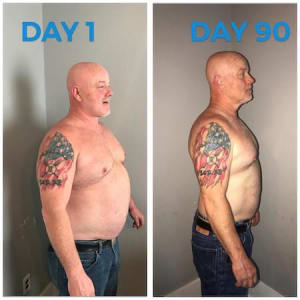
‘The clickbait headlines will shout out “Lose belly fat in 2 weeks!” or, even better, “Lose belly fat overnight!” But you know what they know about things that seem too good to be true. The reality is that there’s no quick way to eliminate belly fat. It is possible to make it disappear, though, and when it comes to your health -- that’s good news. There are two different belly fat types: subcutaneous fat is the surface-level fat that you can pinch. It’s found all over your body, but for many people tends to congregate in the belly, hips and thighs. (Think of the “pear” shape.) Visceral fat is the deep, untouchable fat that’s wrapped around your organs. People who are described as “apple” shaped, or as having a beer belly, are likely dealing with visceral fat. The type of fat you have, and where you have it, can be affected by a number of factors, including genetics, hormones, stress, too much alcohol, too little sleep, smoking, poor diet or lack of exercise. But even if you take good care of yourself and have no subcutaneous fat, you can still have unseen visceral fat. It’s a body type known as TOFI -- thin outside fat outside. While it’s unhealthy to have extra fat no matter where it’s located on your body, belly fat can be especially dangerous. Physically, visceral fat is found around many of your vital organs, like your liver, stomach and intestines. Even worse, it can build up in your blood vessels. The more visceral fat you have, the more pressure it exerts. One of the biggest areas of the body that can be impacted by excess belly fat is your liver. That’s because visceral fat tends to collect near the portal vein, which carries blood from the intestines to the liver. The fat releases substances like free fatty acids that get into the portal vein and make their way to the liver, where they can raise cholesterol, lower good cholesterol, and cause insulin resistance. This, in turn, can lead to Type 2 diabetes. The list of other medical issues linked to having too much belly fat is long, and includes cardiovascular disease, high blood pressure, stroke, blood clots, asthma, breast cancer, colon cancer and even dementia. To read more about each connection, click the links. Although some contributing factors to excess belly fat are out of our control, many others aren’t. And one of the best ways to reverse excess belly fat is to reverse the activities that cause it. For example, alcohol, smoking, stress and inadequate sleep are all things that can be remedied and lead to not only better physical health, but mental health as well. If your fat is caused by a poor diet, for example, be careful of your portion sizes and choose foods that contain complex carbohydrates, like whole grains, fruits and veggies. A lack of exercise can be remedied by simple things like taking the stairs, going on walks, or starting an exercise routine. Aim for a minimum of 30 minutes a day, although up to 60 is ideal. Strength training can help fight subcutaneous fat as well, but highly targeted exercises like sit-ups won’t target visceral fat. If you need a little help keeping track of your food, exercise and how it’s affecting your body, my 28-Day Fat Burning Challenge is full of recipe ideas, grocery lists, and other great ways to stay motivated during your journey. How long does it take to lose belly fat?
What is belly fat?
Why is belly fat dangerous?
How do I lose belly fat?
